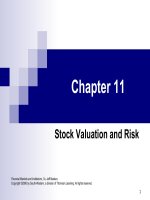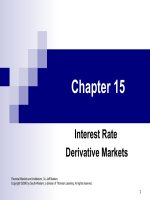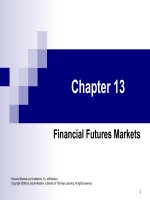Thị trường tài chính và các định chế tài chính_ Chapter 13
Bạn đang xem bản rút gọn của tài liệu. Xem và tải ngay bản đầy đủ của tài liệu tại đây (368.69 KB, 44 trang )
1
Chapter 13
Financial Futures Markets
Financial Markets and Institutions, 7e, Jeff Madura
Copyright ©2006 by South-Western, a division of Thomson Learning. All rights reserved.
2
Chapter Outline
Background on financial futures
Interpreting financial futures tables
Valuation of financial futures
Explaining price movements of bond
futures contracts
Speculating with interest rate futures
Closing out the futures position
3
Chapter Outline (cont’d)
Hedging with interest rate futures
Bond index futures
Stock index futures
Single stock futures
Risk of trading futures contracts
Regulation in the futures markets
Institutional use of futures markets
Globalization of futures markets
4
Background on Financial Futures
A financial futures contract is a standardized
agreement to deliver or receive a specified amount of a
specified financial instrument at a specified price and
date
The buyer of a futures buys the instrument while the seller
delivers the instrument
Futures are traded on organized exchanges
The exchanges clear, settle, and guarantee all transactions that
occur on the exchange
Futures are regulated by the Commodity Futures
Trading Commissions (CFTC)
Approves futures contracts and imposes regulations
5
Background on Financial Futures
(cont’d)
Interest rate futures are on debt securities
such as T-bills, T-notes, T-bonds, and
Eurodollar CDs
Stock index futures are on stock indexes
Settlement dates are in March, June,
September, and December
Most financial futures are traded on the
Chicago Board of Trade or the Chicago
Mercantile Exchange
6
Background on Financial Futures
(cont’d)
Purpose of trading financial futures
Traded either to speculate on prices of securities or to hedge
existing exposure to security price movements
Speculators take positions to profit from expected changes in
the price of futures contracts over time
Day traders attempt to capitalize on price movements during a
single day
Position traders maintain their futures positions for longer
periods of time
Hedgers take positions to reduce their exposure to future
movements in interest rates or stock prices
7
Background on Financial Futures
(cont’d)
Electronic trading
The Chicago Mercantile Exchange established
GLOBEX that compliments its floor trading
Allows for around the clock and weekend trading
The Chicago Board Options Exchange implemented
a fully electronic futures exchange in 2004
8
Background on Financial Futures
(cont’d)
Steps involved in trading futures
Members of a futures exchange are either:
Commission brokers, who execute orders for their
customers and are often employed by brokerage firms
Floor traders (locals), who trade futures contracts for their
own account
Many types of futures contracts now trade over the
counter
Are more personalized and can be tailored to the specific
preferences of the parties involved
9
Background on Financial Futures
(cont’d)
Steps involved in trading futures (cont’d)
Customers must establish margin deposits with their brokers
Initial margin is typically between 5 and 18 percent of a futures’
full value
A futures contract price is “marked to market” daily
Customers may receive a margin call if the value moves in an
unfavorable direction
A market order is executed at the prevailing price of the futures
contract
A limit order is executed only if the price is within the limit
specified
10
Background on Financial Futures
(cont’d)
Steps involved in trading futures (cont’d)
How orders are executed
Brokerage firms communicate customers’ order to
telephone stations located near the trading floor
Floor brokers accommodate orders
When two traders on the floor reach an agreement through
open outcry, the information is transmitted to the customers
Floor brokers receive transaction fees in the form of a bid-
ask spread
The futures exchange acts as a clearinghouse
11
Interpreting Financial Futures
Tables
The Wall Street Journal provides a
comprehensive summary of trading activity on
various financial futures contracts
Example of Treasury bill futures quotations:
Discount
Open High Low Settle Change Settle Change Open
Sept 2005 93.80 94.05 93.80 94.05 +.28 5.95 –.28 2,519
12
Characteristic of
Futures Contract
Treasury Bond Futures Treasury Note Futures
Size $100,000 face value $100,000 face value
Deliverable grade Treasury bonds maturing at least 15
years from date of delivery is not
callable; coupon rate is 8%
Treasury notes maturing at least
6.5 years but not more than 10
years from the first day of the
delivery month; coupon rate is
6%
Price quotation In points ($1,000) and thirty-seconds
of a point
In points ($1,000) and thirty-
seconds of a point
Minimum price
fluctuation
One thirty-second (1/32) of a point,
or $31.25 per contract
One thirty-second (1/32) of a
point, or $31.25 per contract
Daily trading limits Three points ($3,000) per contract
above or below the previous day’s
settlement price
Three points ($3,000) per
contract above or below the
previous day’s settlement price
Settlement months March, June, September, December March, June, September,
December
13
Valuation of Financial Futures
The price of a financial futures contract generally reflects
the expected price of the underlying security as of the
settlement date
As the market price of the financial asset changes, so will the
value of the contract
Factors that influence the expected price of the asset influence
the futures’ price:
The current price of the asset
Economic or market conditions
Impact of the opportunity cost
Investors who buy stock index futures instead of the stock index
do not receive any dividends
Investors who buy stock index futures put up a much smaller
investment
14
Explaining Price Movements of
Bond Futures Contracts
Participants in the Treasury bond futures market closely
monitor the same economic indicators monitored by
participants in the Treasury bond market:
Employment
GDP
Retail sales
Industrial production
Consumer confidence
Inflation indicators
Indicators that reflect the amount of long-term financing
15
Speculating with Interest Rate
Futures
Involves trading T-bill futures
The position taken depends on interest rate
expectations
If interest rates are expected to decline, purchase T-bill futures
If interest rates are expected to increase, sell T-bill futures
The maximum possible loss when purchasing futures is
the amount to be paid for the securities
16
Speculating with Interest Rate
Futures (cont’d)
0
0
Payoff from Purchasing Futures Payoff from Selling Futures
MV of Futures
at Settlement
MV of Futures
at Settlement
17
Speculating on Increasing
Interest Rates
An investor anticipates that interest rates are going to
decrease. Consequently, she purchases a T-bill futures
contract for 94.20 in February. On the March settlement
date, the T-bill futures contract has a price of 94.70.
What is the investor’s nominal profit from this strategy?
000,5$000,942$000,947$Profit =−=









